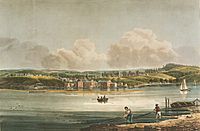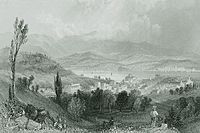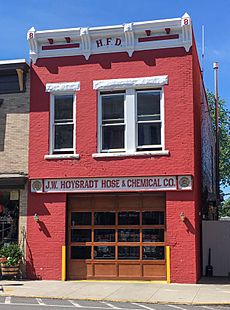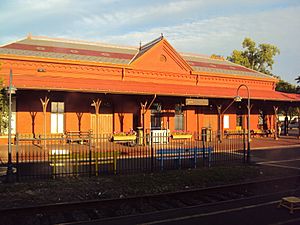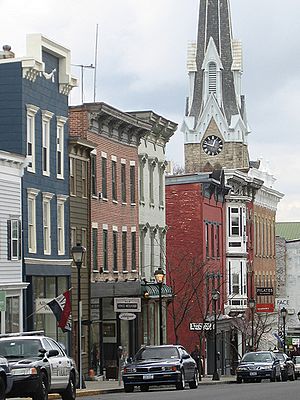Hudson, New York facts for kids
Quick facts for kids
Hudson
|
|
|---|---|
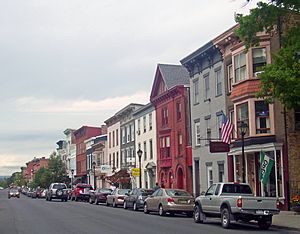
Warren Street in Hudson
|
|
| Etymology: From Henry Hudson | |
| Nickname(s):
The Friendly City
|
|
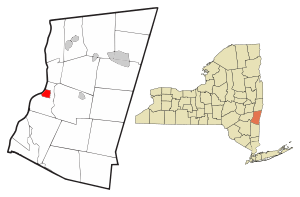
Location of Hudson, New York
|
|
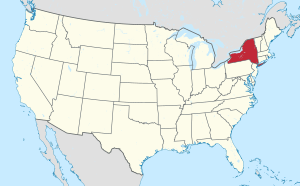
Location of New York in the United States
|
|
| Country | |
| State | |
| County | |
| Founded | Incorporated |
| Area | |
| • Total | 2.33 sq mi (6.03 km2) |
| • Land | 2.16 sq mi (5.59 km2) |
| • Water | 0.17 sq mi (0.45 km2) |
| Elevation | 100 ft (30 m) |
| Highest elevation | 420 ft (130 m) |
| Population
(2020)
|
|
| • Total | 5,894 |
| • Density | 2,731.23/sq mi (1,054.60/km2) |
| Time zone | UTC-5 (Eastern (EST)) |
| • Summer (DST) | UTC-4 (EDT) |
| ZIP Code |
12534
|
| Area codes | 518 |
| FIPS code | 36-021-35969 |
| GNIS feature ID | 0953386 |
| Wikimedia Commons | Hudson, New York |
Hudson is a city in Columbia County, New York, United States. It is located on the east side of the Hudson River, about 120 miles (193 km) from the Atlantic Ocean. The city was named after Henry Hudson, the explorer of the river.
In 2020, the city had a population of 5,894 people. Hudson is known for its history as a port city and its beautiful old buildings.
Contents
History of Hudson
The land where Hudson now stands was bought from the native Mahican people by Dutch settlers in 1662. It was first part of a town called Claverack and was known as "Claverack Landing."
Whalers and merchants from New England, especially from Nantucket, Martha's Vineyard, and Providence, settled here. Hudson officially became a city in 1785. The city grew very quickly as a busy port. It almost became the capital of New York state, missing by just one vote!
Growth and Famous Residents
By 1790, Hudson was the 24th largest city in the United States. By 1820, it was the fourth largest city in New York. Martin Van Buren, who later became a U.S. President, opened his first law office in Hudson.
Many important people were born or lived in Hudson. General William J. Worth, a hero of the Mexican–American War, was born on Union Street in Hudson in 1794. A street in the city, Worth Avenue, is named after him, as is Fort Worth, Texas.
Sanford Robinson Gifford, a famous landscape painter from the Hudson River School, was born in Hudson in 1823. He is buried in Hudson's Cedar Park Cemetery.
The Hudson Half Dollar
In 1935, to celebrate Hudson's 150th birthday, the United States Mint made a special coin called the Hudson Half Dollar. Only 10,008 of these coins were made, making it one of the rarest U.S. coins.
The front of the coin shows Henry Hudson's ship, the Half Moon. The back shows the city's official seal. Some people say President Franklin D. Roosevelt ordered the coin to thank Hudson for supporting him early in his political career.
City Revival and Architecture
After a tough time in the 1960s and 70s, Hudson started to bounce back. In the mid-1980s, many antique dealers opened shops on Warren Street, the city's main street. The Hudson Antiques Center and the English Antiques Center were some of the first.
Now, there are almost seventy antique shops in Hudson. This business growth led to more people moving to the city. Hudson is now famous for its lively arts scene, unique shops, restaurants, art galleries, and fun nightlife.
Hudson has many historic buildings. It's often called the "finest dictionary of American architecture in New York State." Hundreds of properties are listed or can be listed on the State and National Registers of historic places. This means they are important historical buildings.
Community and Development
From 1998 to 2005, there was a big disagreement about a plan to build a large cement factory near Hudson. A company called St. Lawrence Cement wanted to build a huge, coal-fired factory. Many local citizens and groups like Friends of Hudson (FOH) strongly opposed the project.
The fight got national attention from news channels like CNN and The New York Times. In the end, the project was stopped because it didn't fit with the state's coastal rules. This was a big win for the people who opposed it.
Many historic buildings in Hudson are listed on the National Register of Historic Places. These include the Dr. Oliver Bronson House and Estate, Henry A. and Evanlina Dubois House, and the Hudson/Athens Lighthouse.
-
Artist's rendering of fishermen on the Athens side of the Hudson, with view of City of Hudson waterfront (date unknown)
Geography of Hudson
Hudson has a total area of about 2.3 square miles (6.0 sq km). Most of this is land, with a small part being water.
The city is located on a piece of land that extends into the Hudson River. This area was once a spit of land between the South Bay and North Bay.
Across the Hudson River is the town of Athens. A ferry used to connect Hudson and Athens in the 1800s. Between the two towns is Middle Ground Flats, a former sandbar that has grown over time. The town of Greenport borders Hudson on its other three sides.
Population and Demographics
| Historical population | |||
|---|---|---|---|
| Census | Pop. | %± | |
| 1790 | 2,584 | — | |
| 1800 | 3,664 | 41.8% | |
| 1810 | 4,048 | 10.5% | |
| 1820 | 5,310 | 31.2% | |
| 1830 | 5,392 | 1.5% | |
| 1840 | 5,672 | 5.2% | |
| 1850 | 6,286 | 10.8% | |
| 1860 | 7,187 | 14.3% | |
| 1870 | 8,615 | 19.9% | |
| 1880 | 8,670 | 0.6% | |
| 1890 | 9,970 | 15.0% | |
| 1900 | 9,528 | −4.4% | |
| 1910 | 11,417 | 19.8% | |
| 1920 | 11,745 | 2.9% | |
| 1930 | 12,337 | 5.0% | |
| 1940 | 11,517 | −6.6% | |
| 1950 | 11,629 | 1.0% | |
| 1960 | 11,075 | −4.8% | |
| 1970 | 8,940 | −19.3% | |
| 1980 | 7,986 | −10.7% | |
| 1990 | 8,034 | 0.6% | |
| 2000 | 7,524 | −6.3% | |
| 2010 | 6,713 | −10.8% | |
| 2020 | 5,894 | −12.2% | |
| U.S. Decennial Census | |||
In 2010, Hudson had 6,713 people living in the city. This number includes about 360 people living at the Hudson Correctional Facility.
The population has changed over the years. More retirees, young couples, and people without children have moved to Hudson. They have helped restore many homes in the city.
The city's population is diverse. In 2010, about 59% of the people were White, 25% were African American, and 7.1% were Asian. About 8.2% of the population was Hispanic or Latino.
The median age in Hudson was 37.5 years. This means half the people were younger than 37.5, and half were older.
Economy and Tourism
After a period of economic decline in the 1960s and 70s, Hudson's economy has greatly improved. It has shifted from manufacturing to tourism and services.
The city's beautiful architecture attracted many antique dealers in the 1980s. This led to a boom in tourism and new residents. Today, Hudson is known for its many antique shops, art galleries, restaurants, and lively arts scene.
Hudson has a high number of independent artists. A 2014 study showed that Hudson has more artists than almost any other county in the U.S. This shows how important art and creativity are to the city's economy.
Transportation in Hudson
You can travel to Hudson by train using Amtrak. The Hudson station provides passenger rail service.
Local bus service is provided by Columbia County Public Transportation. You can also take a bus to Albany.
The Hudson Ferry Company offers ferry service across the Hudson River to Athens, New York.
Attractions and Things to Do
Hudson has many interesting places to visit.
- The Firemen's Association of the State of New York (FASNY) Museum of Firefighting is one of the largest fire service museums in the world. It's located on the grounds of the FASNY Firemen's home, which was the first nursing home for firefighters in the country.
- The Hudson Music Festival was a popular annual event. It was New York's largest free music festival, showcasing many different musical acts.
- Hudson Hall is an arts venue on Warren Street. It is the oldest operating theater in New York.
- Time & Space Limited is an arts organization that shows a variety of independent movies.
- A farmers market takes place every Saturday. You can find fresh, local products from the Hudson Valley area. The market is outdoors in warm weather and indoors in winter.
- Olde York Farm is a unique distillery. It is owned by a woman and run by a family. They use local ingredients to make spirits like bourbon, whiskey, and brandy. The farm is part of a historic property that once had its own distillery in the 1800s.
Many local restaurants in Hudson use fresh ingredients from nearby farms.
Historic Properties to Explore
Hudson is famous for its historic buildings. It has been called the "finest dictionary of American architecture in New York State." Many buildings in the Hudson Historic District are considered important historical properties.
These historic places include:
- The Dr. Oliver Bronson House and Estate
- The Henry A. and Evanlina Dubois House
- The Cornelius H. Evans House
- The Hudson/Athens Lighthouse
- The United States Post Office
- The William Henry Ludlow House
-
Artist's rendering of fishermen on the Athens side of the Hudson, with view of City of Hudson waterfront (date unknown)
Notable people
Many interesting people have lived in or are from Hudson:
- Marina Abramović, a performance artist.
- John Ashbery, a New York State poet laureate.
- Melissa Auf der Maur, a musician from bands like The Smashing Pumpkins and Hole. She also owns Basilica Hudson, an arts venue.
- Rashad Barksdale, a former football player for the New York Giants.
- J. D. Cannon, an actor.
- Sanford Robinson Gifford, a famous landscape painter.
- Kirsten Gillibrand, a politician and member of the United States Senate.
- Malcolm Gladwell, a well-known author and journalist.
- Gaby Hofmann, an actress.
- Martin Van Buren, who became a U.S. president.
- William Jenkins Worth, a general in the Mexican–American War.
See also
 In Spanish: Hudson (Nueva York) para niños
In Spanish: Hudson (Nueva York) para niños


